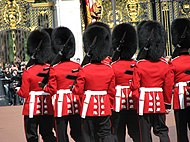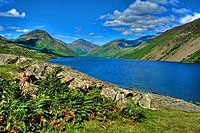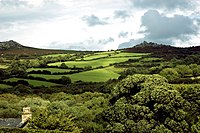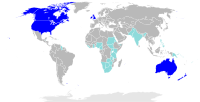Prehistory and antiquity
Main article: Prehistoric Britain

Stonehenge, a Neolithic monument The oldest proto-human bones discovered in the area date from 700,000 years ago. The discovery, of Homo erectus remains, was made in what is today Norfolk and Suffolk. Modern humans first arrived in the area around 35,000 years ago; but due to the tough conditions of the Last Ice Age, known specifically in this area as the Devensian glaciation, they fled from Britain to the mountains of southern Europe. Only large mammals such as mammoths, bison and woolly rhinoceros remained. Roughly 11,000 years ago, when the ice sheets began to recede, humans repopulated the area; genetic research suggests they came from the northern part of the Iberian Peninsula. The sea level was lower than now, and Britain was connected by land to both Ireland and Eurasia. As the seas rose, it was separated from Ireland 9,000 years ago and from Eurasia half a century later. Beaker culture arrived around 2500 BC, and the making of food vessels constructed out of clay and copper was introduced. It was during this time that major Neolithic monuments such as Stonehenge and Avebury were constructed. By heating together tin and copper, both of which were in abundance in the area, the Beaker culture people were able to make bronze, and later iron from iron ores. They were able to spin and weave sheep's wool, from which they made clothing.

Boudica led an uprising against the Roman Empire. During the Iron Age, Celtic culture, deriving from the Hallstatt and La Tène cultures, arrived from Central Europe. The development of iron smelting allowed the construction of better ploughs, advancing agriculture (for instance, with Celtic fields), as well as the production of more effective weapons. Brythonic was the spoken language during this time. Society was tribal; according to Ptolemy's Geographia there were around 20 different tribes in the area, however earlier divisions are unknown because the Britons were not literate. Like other regions on the edge of the Empire, Britain had long enjoyed trading links with the Romans. Julius Caesar of the Roman Republic attempted to invade twice in 55 BC; although largely unsuccessful, he managed to set up a client king from the Trinovantes. The Romans conquered Britain in AD 43 during the reign of Emperor Claudius, and the area was incorporated into the Roman Empire as Britannia province.[27] The best known of the native tribes who attempted to resist were the Catuvellauni led by Caratacus. Later, an uprising led by Boudica, queen of the Iceni, resulted in her death at the Battle of Watling Street. This era saw a Greco-Roman high culture prevail with the introduction of law and order, Roman architecture, personal hygiene, sewage systems, education, many agricultural items, and silk. In the 3rd century, Emperor Septimius Severus died at York, where Constantine was subsequently proclaimed emperor. Christianity was first introduced around this time, though there are traditions linked to Glastonbury claiming an introduction through Joseph of Arimathea, while others claim through Lucius of Britain. By 410, as their Empire declined, the Romans had left the island, to defend their frontiers in continental Europe.
Middle Ages
Main article: England in the Middle Ages
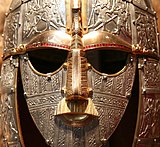
A 7th century ceremonial helmet from the Kingdom of East Anglia, found at Sutton Hoo Following the Roman retreat, Britain was left open to invasion by pagan, seafaring warriors such as Saxons and Jutes who gained control in areas around the south east. The advance was contained for a while after the Britons' victory at the Battle of Mount Badon. The Sub-Roman Brythonic kingdoms in the north, later known collectively by British bards as the Hen Ogledd, were also gradually conquered by Angles during the 6th century. Reliable contemporary accounts from this period are scarce, as is archaeological evidence, giving rise to its description as a Dark Age. There are various conflicting theories on the extent and process of the Anglo-Saxon settlement of Britain; Cerdic, founder of the Wessex dynasty, may have been a Briton.Nevertheless, by the 7th century a coherent set of Anglo-Saxon petty kingdoms known as the Heptarchy had emerged in southern and central Britain: Northumbria, Mercia, East Anglia, Essex, Kent, Sussex, and Wessex. Christianity was introduced in the south by Augustine from Rome and in the north by Aidan from Ireland. This reintroduced Christianity, which was lost after the founding of the Heptarchy. The title Bretwalda, meaning "Lord of the Britons", denoted the most influential kingship. Northumbria and Mercia were the most dominant forces early on. However, following Viking conquests in the north and east, and the imposition of Danelaw, the premier English kingdom became Wessex under Alfred the Great. His grandson Athelstan unified England in 927, although this was only cemented after Edred defeated the Viking Eric Bloodaxe. King Cnut the Great briefly incorporated England into an empire which also included Denmark and Norway.However the Wessex dynasty was restored under Edward the Confessor.

Victory at the Battle of Agincourt, fought on Saint Crispin's Day England was conquered in 1066 by an army led by William the Conquerer from the Duchy of Normandy, a fief of the Kingdom of France. The Normans themselves originated from Scandinavia and had settled in Normandy a few centuries earlier. They introduced feudalism and maintained power through barons, who set up castles across England. The spoken language of the new aristocratic elite was Norman French, which would have considerable influence on the English language. The House of Plantagenet from Anjou inherited the English throne under Henry II, adding England to the budding Angevin Empire of fiefs the family had inherited in France including Aquitaine. They reigned for three centuries, proving noted monarchs such as Richard I, Edward I, Edward III and Henry V. The period saw improvements in trade and legislation, including the signing of the Magna Carta. Catholic monasticism flourished, providing philosophers and the universities of Oxford and Cambridge were founded with royal patronage. The Principality of Wales became a Plantagenet fief during the 13th century and the Lordship of Ireland was gifted to the English monarchy by the Pope. During the 14th century, the Plantagenets and House of Valois both claimed to be legitimate claimants to House of Capet and with it France—the two powers clashed in the Hundred Years' War.[41] The Black Death epidemic hit England, starting in 1348, it eventually killed up to half of the countries inhabitants. From 1453 to 1487 civil war between two branches of the royal family occurred—the Yorkists and Lancastrians—known as the Wars of the Roses. Eventually it led to the Yorkists losing the throne entirely to a Welsh noble family the Tudors, a branch of the Lancastrians headed by Henry Tudor who invaded with Welsh and Breton mercenaries, gaining victory at the Battle of Bosworth Field where the Yorkist king Richard III was killed.
Early Modern

became
King Henry VIIISupreme Governor of the Church of England. The Tudor period would prove to be eventful.The Renaissance reached England through Italian courtiers, who reintroduced artistic, educational and scholary debate from classical antiquity. During this time England began to develop naval skills, including inventing the theodolite and exploring to the West. The catalyst for such explorations, was the Ottoman Empire's control of the Mediterranean Sea, which blocked off trade with the East for the Christian states of Europe.[46] Henry VIII broke from communion with the Catholic Church, over issues relating to divorce, under the Acts of Supremacy in 1534 which proclaimed the monarch head of the Church of England. Contrary to much of European Protestantism, the roots of the split were more political than theological.[note 2] Tudor also legally incorporated his ancestral land Wales into the Kingdom of England with the 1535–1542 acts. There were internal religious conflicts during the reigns of Henry's daughters; Mary I and Elizabeth I. The former attempted to bring the country back to Catholicism, while the later broke from it again more forcefully asserting the supremacy of Anglicanism.[46] An English fleet under Francis Drake defeated an invading Spanish Armada during the Elizabethan period. Competing with Spain, the first English colony in the Americas was founded by explorer Walter Raleigh in 1585 and named Virginia. With the East India Company, England also competed with the Dutch and French to the East. The nature of the island was changed, when the Stuart King of Scotland, from a kingdom which was previously a long time rival, inherited the throne of England—creating a personal union under James I in 1603. He styled himself King of Great Britain, despite having no basis in English law.

The English Restoration restored the monarchy under King Charles II and peace after the English Civil War.
Based on conflicting political, religious and social positions, there was an English Civil War between the supporters of Parliament and those of king Charles I, known as Roundheads and Cavaliers respectively. This was an interwoven part of the wider multifacited Wars of the Three Kingdoms, involving Scotland and Ireland. The Parliamentarians were victorious, Charles I was executed and the kingdom replaced with the Commonwealth. Leader of the Parliament forces, Oliver Cromwell declared himself Lord Protector in 1653, a period of personal rule followed.By the time of Cromwell's death, England had largely grown weary of Puritan rule, many wanted to patch up old wounds and so Charles II was invited to return as monarch in 1660 with the Restoration. It was now constitutionally established that King and Parliament should rule together, though in practice this was not fully cemeted until the following century. With the founding of the Royal Society, science and the arts were encouraged. The Great Fire of London in 1666 gutted the capital but it was rebuilt shortly after.In Parliament two factions had emerged—the Tories and Whigs. The former were royalists while the latter were classical liberals. Though the Tories initially supported Catholic king James II, some of them, along with the Whigs deposed him at the Revolution of 1688 and invited Dutch prince William III to become monarch. Some English people, especially in the north were Jacobites and continued to support James and his sons. After the parliaments of England and Scotland both agreed,the two countries joined in political union, to create the Kingdom of Great Britain in 1707. To accomodate the union, institutions such as the law and national church of each remained separate.
Late Modern and contemporary

The World Heritage Site — Saltaire, West Yorkshire is a model mill town from the Industrial Revolution. Under the newly formed Kingdom of Great Britain, output from the Royal Society and other English initiatives combined with the Scottish Enlightenment to create innovations in science and engineering. This paved the way for the establishment of the British Empire, which became the largest in history. Domestically it drove the Industrial Revolution, a period of profound change in the socioeconomic and cultural conditions of England, resulting in industrialised agriculture, manufacture, engineering and mining, as well as new and pioneering road, rail and water networks to facilitate their expansion and development. The opening of northwest England's Bridgewater Canal in 1761 ushered in the canal age in Britain.[56][57] In 1825 the world's first permanent steam locomotive-hauled passenger railway—the Stockton and Darlington Railway—opened to the public. During the Industrial Revolution, many workers moved from England's countryside to new and expanding urban industrial areas to work in factories, for instance at Manchester and Birmingham, dubbed "Warehouse City" and "Workshop of the World" respectively. England maintained relative stability throughout the French Revolution; William Pitt the Younger was British Prime Minister for the reign of George III. During the Napoleonic Wars, Napoleon Bonaparte planned to invade from the south-east. However this failed to manifest and the Napoleonic forces were defeated by the British at sea by Lord Nelson and on land by the Duke of Wellington. The Napoleonic Wars fostered a concept of Britishness and a united national British people, shared with the Scots and Welsh.

The Cenotaph at Whitehall is a memorial to members of the British Armed Forces who died during the two World Wars. London became the largest and most populous metropolitan area in the world during the Victorian era, and trade within the British Empire—as well as the standing of the British military and navy—was prestigious. Political agitation at home from radicals such as the Chartists and the suffragettes enabled legislative reform and universal suffrage. Power shifts in east-central Europe led to World War I; thousands of English soldiers died in trenches fighting for the United Kingdom as part of the Allies. Two decades later, in World War II, the United Kingdom again fought for the Allies. Winston Churchill was the wartime Prime Minister.Developments in warfare technology saw many cities damaged by air-raids during The Blitz. Following the war the British Empire experienced rapid decolonisation, as well as a series of technological innovations—automobiles became the primary means of transport and Whittle's development of the jet engine led to wider air travel. Since the 20th century there has been significant population movement to England, mostly from other parts of the British Isles, but also from the Commonwealth, particularly the Indian subcontinent. Since the 1970s there has been a large move away from manufacturing and an increasing emphasis on the service industry. As part of the United Kingdom, the area joined a common market initiative called the European Economic Community which became the European Union. Since the late 20th century the administration of the United Kingdom has moved towards devolved governance in Scotland, Wales and Northern Ireland.England and Wales continues to exist as a legal entity within the United Kingdom. Devolution has stimulated a greater emphasis on a more English-specific identity and patriotism. There is no devolved English government, but an attempt to create a similar system on a sub-regional basis was rejected by referendum.












